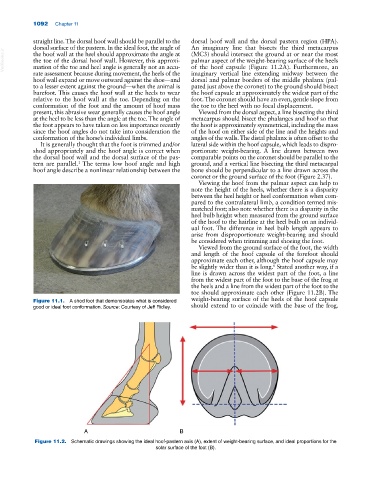Page 1126 - Adams and Stashak's Lameness in Horses, 7th Edition
P. 1126
1092 Chapter 11
straight line. The dorsal hoof wall should be parallel to the dorsal hoof wall and the dorsal pastern region (HPA).
dorsal surface of the pastern. In the ideal foot, the angle of An imaginary line that bisects the third metacarpus
VetBooks.ir the toe of the dorsal hoof wall. However, this approxi palmar aspect of the weight‐bearing surface of the heels
(MC3) should intersect the ground at or near the most
the hoof wall at the heel should approximate the angle at
of the hoof capsule (Figure 11.2A). Furthermore, an
mation of the toe and heel angle is generally not an accu
rate assessment because during movement, the heels of the imaginary vertical line extending midway between the
hoof wall expand or move outward against the shoe—and dorsal and palmar borders of the middle phalanx (pal
to a lesser extent against the ground—when the animal is pated just above the coronet) to the ground should bisect
barefoot. This causes the hoof wall at the heels to wear the hoof capsule at approximately the widest part of the
relative to the hoof wall at the toe. Depending on the foot. The coronet should have an even, gentle slope from
conformation of the foot and the amount of hoof mass the toe to the heel with no focal displacement.
present, this abrasive wear generally causes the hoof angle Viewed from the dorsal aspect, a line bisecting the third
at the heel to be less than the angle at the toe. The angle of metacarpus should bisect the phalanges and hoof so that
the foot appears to have taken on less importance recently the hoof is approximately symmetrical, including the mass
since the hoof angles do not take into consideration the of the hoof on either side of the line and the heights and
conformation of the horse’s individual limbs. angles of the walls. The distal phalanx is often offset to the
It is generally thought that the foot is trimmed and/or lateral side within the hoof capsule, which leads to dispro
shod appropriately and the hoof angle is correct when portionate weight‐bearing. A line drawn between two
the dorsal hoof wall and the dorsal surface of the pas comparable points on the coronet should be parallel to the
tern are parallel. The terms low hoof angle and high ground, and a vertical line bisecting the third metacarpal
1
hoof angle describe a nonlinear relationship between the bone should be perpendicular to a line drawn across the
coronet or the ground surface of the foot (Figure 2.37).
Viewing the hoof from the palmar aspect can help to
note the height of the heels, whether there is a disparity
between the heel height or heel conformation when com
pared to the contralateral limb, a condition termed mis
matched foot; also note whether there is a disparity in the
heel bulb height when measured from the ground surface
of the hoof to the hairline at the heel bulb on an individ
ual foot. The difference in heel bulb length appears to
arise from disproportionate weight‐bearing and should
be considered when trimming and shoeing the foot.
Viewed from the ground surface of the foot, the width
and length of the hoof capsule of the forefoot should
approximate each other, although the hoof capsule may
be slightly wider than it is long. Stated another way, if a
6
line is drawn across the widest part of the foot, a line
from the widest part of the foot to the base of the frog at
the heels and a line from the widest part of the foot to the
toe should approximate each other (Figure 11.2B). The
Figure 11.1. A shod foot that demonstrates what is considered weight‐bearing surface of the heels of the hoof capsule
good or ideal foot conformation. Source: Courtesy of Jeff Ridley. should extend to or coincide with the base of the frog.
A B
Figure 11.2. Schematic drawings showing the ideal hoof‐pastern axis (A), extent of weight‐bearing surface, and ideal proportions for the
solar surface of the foot (B).

